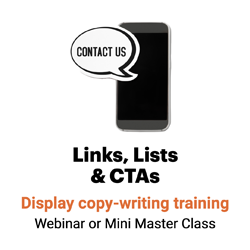5 ways to draw eyes, fingers
Your most important links are calls to action, writes HubSpot’s Kyle James. So how can you increase the chances that they’ll get clicked? Follow these five tips:

1. Avoid Fat Fingers/No Bars Syndrome.
Make “touch targets” at least 1cm × 1cm (0.4in × 0.4in) for mobile users.
2. Bold-face your most important links.
Visitors are 20% more likely to click on a bold-faced link, according to HubSpot research.
3. Go graphic.
Clickable images with text under them increased click-through rates by 100% in one Hubspot test.
4. Keep your call to action above the fold.
5. Underline links and make them a different color.
Web users have learned to see underlined, colored text as links. Don’t make them learn a new approach for using your website.
“Users shouldn’t have to guess or scrub the page to find out where they can click,” writes usability expert Jakob Nielsen.
And if it’s not a link, don’t underline it. If you do, someone will click it. And that will confuse and irritate your visitors.
6. Make visited links a different color.
Reserve blue for unvisited links and use a clearly different, less saturated color for visited links, Nielsen suggests.
Some sites use gray for visited links, but Nielsen recommends that you avoid this practice. That’s because gray type is hard to read, and it’s often used online to show that something is unavailable.
7. Label links that do anything other than open a different webpage.
Let readers know if they’re opening a video or PDF by adding or [PDF] after the link.
Read Nielsen’s Guidelines for Visualizing Links and Link List Color on Intranets.
____
Sources: Kyle James, “9 Ways to Optimize Your Links and Draw Attention to Your Calls to Action,” HubSpot’s Inbound Internet Marketing Blog, March 4, 2009
Jakob Nielsen, “Guidelines for Visualizing Links,” Nielsen Norman Group, May 10, 2004

Leave a Reply